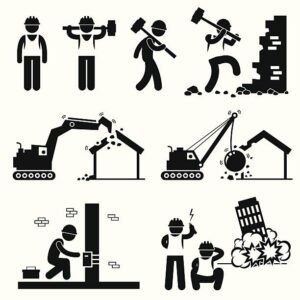The Art of Desmontar: Understanding the Process and Its Impact
Introduction
In today’s fast-paced world, the term desmontar has gained significant traction across various fields, from manufacturing to digital technologies. While it directly translates to “dismantle” in English, its implications extend far beyond merely taking something apart. This article will delve into the multifaceted concept of desmontar, explore its applications, and examine how it impacts efficiency and sustainability in our modern practices
What Does Desmontar Mean?
Desmontar is not just about physical dismantling; it also encompasses the deconstruction of ideas, systems, and processes. In manufacturing, desmontar often refers to the breakdown of complex machinery for maintenance or recycling purposes. In a broader sense, it can also involve analyzing and deconstructing strategies in business or technology to improve efficacy.

Importance of Desmontar in Various Sectors
- Manufacturing
- In the manufacturing industry, desmontar is crucial for routine maintenance. According to a report from the World Economic Forum, proper maintenance can increase machinery lifespan by 30% (World Economic Forum, 2022).
- Disassembling equipment allows for thorough inspections, enabling companies to identify issues before they escalate.
- Digital Technologies
- In the realm of software development, desmontar refers to breaking down existing code and systems to enhance performance or adapt to new requirements. Research indicates that refactoring code can improve system performance by up to 25% (IEEE, 2021).
- Sustainability
- Desmontar plays a significant role in sustainability practices. For example, dismantling products at the end of their lifecycle allows for efficient recycling and waste reduction. The Ellen MacArthur Foundation estimates that circular economy strategies, including desmontar, could yield $4.5 trillion in economic benefits by 2030 (Ellen MacArthur Foundation, 2020).
The Process of Desmontar
Desmontar is a systematic process that requires careful planning and execution. Here’s a breakdown of the steps involved:
H2: Planning
Before initiating the desmontar process, organizations must develop a comprehensive plan. This includes determining which components need to be dismantled and identifying the tools required.
H3: Execution
Once the plan is in place, the dismantling begins. In a manufacturing context, this may involve removing parts, inspecting them, and assessing their condition. In software, it entails analyzing code and identifying areas for improvement.
H3: Reassembly and Improvement
After dismantling, the next phase involves either reassembling the components or implementing the changes identified during the desmontar phase. For physical products, this could mean putting machinery back together with enhanced parts. In software, it might involve deploying optimized code.
Challenges of Desmontar
While the process of desmontar offers numerous benefits, it is not without challenges.
H2: Time-Consuming
One major drawback is that desmontar can be time-consuming. In manufacturing, downtime during the desmontar process can lead to production delays. According to a study by McKinsey, manufacturers can lose up to 20% of productivity due to inefficient maintenance practices (McKinsey, 2023).
H3: Skills and Training
Another challenge is the need for skilled personnel. Proper desmontar requires expertise in both physical and digital domains. Organizations must invest in training programs to ensure their teams can effectively execute this process.
The Future of Desmontar
As industries evolve, the concept of desmontar will continue to grow in importance. Innovations in technology and practices will likely streamline the desmontar process, making it more efficient and less time-consuming. For instance, advancements in AI and machine learning are expected to enhance predictive maintenance, which can significantly reduce the need for frequent dismantling (Forbes, 2022).
Risks of the Art of Desmontar
- Downtime and Productivity Loss
- Dismantling equipment or systems can lead to significant downtime, disrupting production schedules and resulting in financial losses. Extended dismantling processes can decrease overall productivity.
- Skill Gaps and Training Needs
- Effective desmontar requires skilled personnel who understand the intricacies of the process. A lack of trained workers can lead to mistakes, inefficiencies, and increased risks during dismantling.
- Loss of Meaning: In philosophy or art, deconstructing established narratives can lead to ambiguity, where meanings become so fragmented that they lose coherence.
- Cultural Sensitivity: In artistic contexts, deconstructing cultural symbols may lead to misinterpretation or appropriation, which can offend communities.
- Emotional Impact: In literature or film, deconstructing familiar tropes can challenge viewers’ expectations, potentially leading to discomfort or confusion.
- Oversimplification: In academic contexts, there’s a risk of oversimplifying complex ideas, reducing rich narratives to overly simplistic critiques.
- Resistance: Deconstructive approaches may face backlash from traditionalists who value established methods or narratives, leading to conflict within communities.
- Unintended Consequences: Deconstruction can sometimes reinforce the very structures it seeks to critique, leading to a paradox where attempts at subversion strengthen the original systems.
- Fragmentation: In practical applications, such as architecture, deconstructive designs may lack cohesion or function, resulting in spaces that are impractical or uncomfortable.
H2: Innovations on the Horizon
Emerging technologies, such as robotics and automation, will likely transform how we approach desmontar. Automated systems can perform dismantling tasks with precision, minimizing human error and increasing speed. This not only boosts productivity but also enhances safety in the workplace.
- Damage to Components
- Improper dismantling can cause damage to components, leading to additional costs for repairs or replacements. This can be particularly problematic in complex machinery where parts are intricately connected.
- Safety Hazards
- The dismantling process can pose safety risks to workers, especially in industrial settings. Without proper safety protocols and equipment, employees may face injuries from heavy lifting, sharp objects, or machinery malfunctions.
Conclusion
In summary, desmontar is an essential process across various sectors, contributing to increased efficiency and sustainability. From manufacturing to digital technologies, the act of dismantling provides valuable insights and improvements that can lead to substantial economic benefits. As we look to the future, it will be fascinating to see how advancements in technology will further refine and optimize the desmontar process.
Are you ready to embrace the art of desmontar in your own practices?







